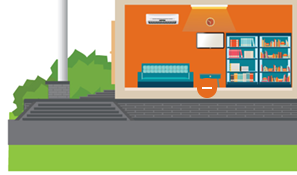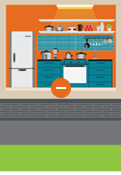Attic, Garage and Insulation
Your attic, garage and basement are the main areas where insulation can improve your home’s energy efficiency. Look below for helpful tips to reduce the electricity bill by properly insulating these areas.
Office and Electronics
In this digital age, electronics are found in every room of the house and many of them have energy-efficient settings. Check out our list below for more information.
Bedroom
Even while you sleep, your home can still use energy. Below we have outlined some tips on saving electricity and staying comfortable without breaking the bank.
Bathroom
This may not be a hot spot for energy efficiency, but there are ways to conserve energy without sacrificing comfort. Check those out below.
Living Room
From lighting to windows to your thermostat, the living room is a great place to make the most out of home energy savings. Read on to see how to reduce electricity bills in your main living space.
Miscellaneous
There are many more ways you can save energy that don’t necessarily fit into one particular room. We have you covered with more tips below.
Kitchen
Even with energy-efficient appliances, you can still learn how to save money on electric bills with the helpful tips you’ll find below.
HVAC – Heating, Ventilation and Air Conditioning
The majority of your energy usage comes from your HVAC system. Below we have outlined numerous tips to help you stay comfortable and maintain your system while lowering your utility bills.
General Information (Air-Source HPs)
- The two main types of heat pumps (HP) are air-source, which move air between the home and outdoor air to provide heating/cooling, and geothermal, which uses the ground or water source to provide heating/cooling.
- Depending on the cost of natural gas and electricity, it may still be less expensive to heat your home with a natural gas furnace vs. heat pump if your location has natural gas.
- Efficiency does not always equal cheaper. Efficiency is how much of a fuel source is used to create heating/cooling. For example, an electric furnace is 100% efficient at producing heat (no fuel is wasted in the process), but the amount of energy needed to adequately heat costs more, relatively speaking, vs. a natural gas furnace which ranges from 80-95% efficient.
Air-Source Heat Pumps
This is the most common type of heat pump. Air-source heat pumps (ASHP) have two coils – one outside and one inside which conditions the indoor air. These work like an air conditioner, but have a reversing valve to essentially run in reverse, permitting heating instead of cooling.
General Information
- ASHPs provide both cool and warm air by the process of moving air molecules from one space to another. (E.g. in the winter, it takes warm air molecules from outside and transfers them inside; vice versa in the summer.)
- Much like a traditional air conditioner, an ASHP is a centralized system with ducts to help distribute the air.
- ASHPs can also be found as room units or Mini Splits. These units do not use duct work, but heat/cool a room directly from an indoor unit in the room attached to an outdoor unit.
- An outdoor thermostat is best for an ASHP system. This thermostat will run the HP first before automatically switching over to the second stage or auxiliary/emergency heat (furnace). This will reduce your electricity cost if you have an electric furnace.
- The outdoor thermostat system should be set to 40 or 35 degrees. This is the outdoor temperature that the system will then switch over to your second stage heating.
Heating Mode
- ASHPs require two-stage thermostats for operation: the first stage is for the compressor of the HP; if that cannot keep up with the needs in the home for heat, the second stage (a furnace) will take over.
- ASHPs are more efficient at delivering heat energy than an electric furnace as they transfer heat from one place to another vs. converting heat from a fuel source.
Geothermal Heat Pumps
Geothermal heat pumps (GHP) work similar to an ASHP, however, instead of moving air from one place to another, they use the consistent temperature of the ground or an outdoor body of water to heat and cool a home.
General Information
- GHPs circulate water from a well (water-source), or they recirculate an antifreeze-water solution running through pipes in the ground (ground-source).
- For the heating cycle, the GHP uses the indoor coil to move heat out of the circulating water and into the home.
- Because they provide heat at a relatively low temperature, as with any heat pump system, GHPs work best in a well-insulated, air tight, energy-efficient home.
- GHPs are more efficient than ASHPs due to the ground’s temperate and consistent temperature.
- GHPs are much more expensive to purchase and install vs. an ASHP.
- The two most common types of GHPs are: water-source heat pumps (i.e. open-loop or groundwater heat pumps), and ground-source heat pumps (i.e. closed-loop geothermal heat pumps).


















